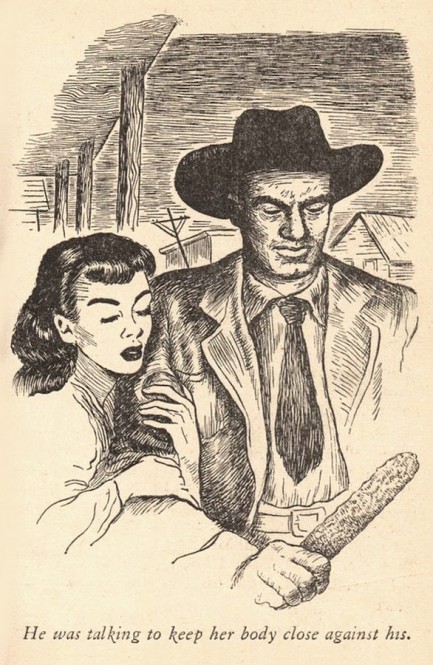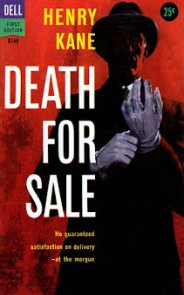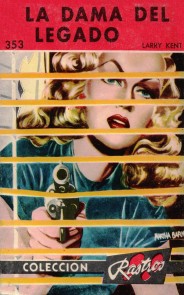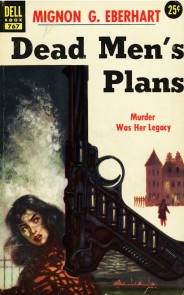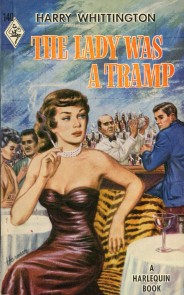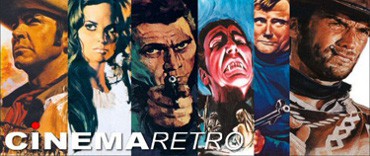 I said I need to stretch my legs. I didn't say you need to stand there and stare at them while I do it. 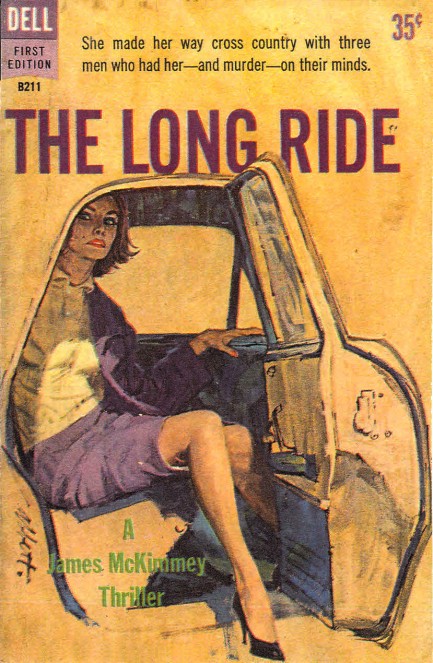
The cover blurb makes James McKimmey's The Long Ride sound as if the trip taken involves a total of one woman and three men. Actually there are seven travelers, headed cross country to San Fransisco, three of whom are involved in a bank robbery and murder in different ways. Obviously, there's the robber. There's also the person whole stole the loot from the robber. And there's—well, we won't say, because this is a good tale that deserves to surprise you. It reminded us tangentially of John D. MacDonald's The Damned, though the ensemble here is much smaller. However, the crucible aspect is similar. In The Damned everyone is stuck at a river crossing, whereas here everyone spends much of their time in a station wagon (with a motel or two mixed in). We read a review of this that said the three main characters ending up in the same car defied credulity. That person must have skimmed the book. It makes perfect sense that they're together, as does every other aspect of the plotting. The only flaw for us was an over-written lonely heart librarian, but otherwise we thought The Long Ride was a thrill ride, not long at all, if anything too short. This Dell paperback is from 1961 with leggy art from Bob Abbett.
 One unlucky spin of the wheel always leads to another. 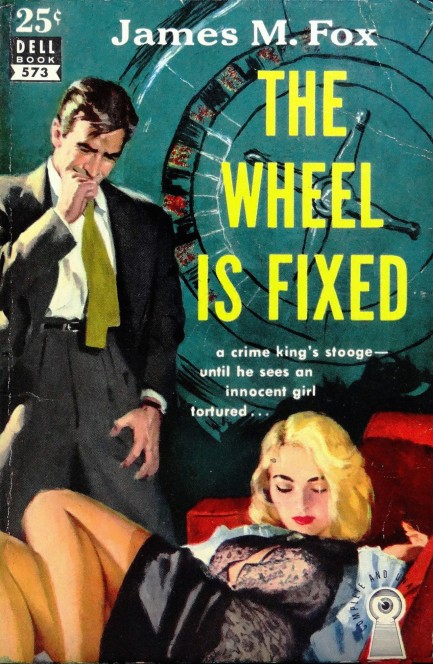
Above is a cover for James M. Fox's, née Johannes Knipscheer's, thriller The Wheel is Fixed, painted by Willard Downs for Dell Publications in 1951. A while back we put together an entire collection of covers featuring roulette wheels and this one was part of the group. But we hadn't read the book, so a few days ago we took care of that. This is the tale of a down-on-his-luck pianist hired to seduce a music loving femme fatale away from from a gangster's violinist son. It starts out interestingly but loses momentum during the middle stretches. We kept reading it anyway because it has a framing device and we were curious how the narrator and his companion came to be in the sorry state they're in when he begins recounting the tale. Like waiting for a roulette wheel to stop, you'll urge the narrative to hurry. It doesn't, but if you're patient there's a payoff, by which we mean a violent climax and a satisfying denouement. Overall it wasn't bad, but would we take Fox for another spin? Probably not.
 This is where being deputy in a one-horse town really sucks. 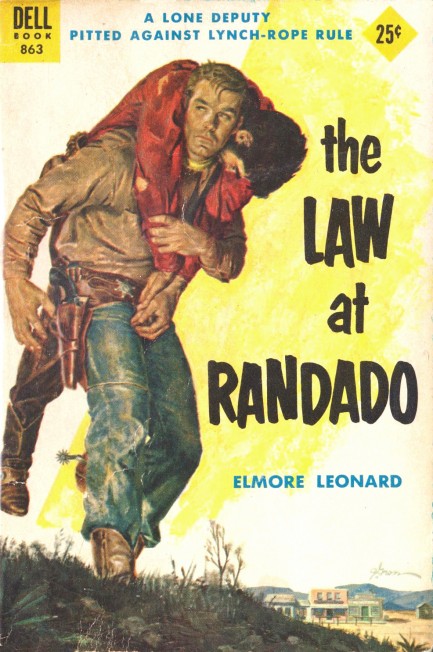
Elmore's Leonard's second novel The Law at Randado was published in 1954, and it debuted in paperback as this Dell edition with evocative George Gross cover art. Leonard wrote scores of fascinating characters during his long career. The villain here is yet another. Arizona cattleman Phil Sundeen inherited his wealth but pretends he earned it. Though he doesn't truly have a head for business the sheer size of his fortune prevents his numerous failures from ruining him. He commits transgressions that range from the rude to the unethical to the outright illegal. Men work for him knowing they'll eventually be humiliated or cheated, but they tell themselves that maybe there's a way to benefit from the relationship before it implodes.
When Sundeen's stupidity and vanity catalyze a deadly mob, deputy sheriff Kirby Frye wants to hold him to account. Though Sundeen encouraged the chaos, rather than physically taking part, there's no doubt he's responsible for the deaths. But most of the people in the town of Randado defend Sundeen. They all harbor fantasies that by staying on his good side fortune will one day smile upon them. His inner circle protect him, but they know he's wrong. They've gained considerable prestige clinging to him, but they try to make him face the reality of his situation anyway, only to learn that their enablement of him—and the enablement of all the sycophants who came before them—have warped Sundeen's sense of reality:
Sundeen looked up now, faintly grinning. “R.D., you old son of a bitch, you telling me [I'm] wrong?
“I'm facing the facts!”
“Facts don't mean a thing.”
“They do when you're faced with them!”
“I don't see 'em facing me. George, you see any facts facing [me]?”
And presented with this, Sundeen's enablers toss what remains of their integrity into a ditch. In public they claim his obvious crimes are not crimes at all, but they know they're lying, and in private they realize he will only get worse. So does Deputy Frye, which is one reason he's determined to apply the law to Sundeen, same as anyone else. His legal authority comes straight from the county seat in Tucson, but that authority means little to a group willing to see their meal ticket as oppressed by an illegitimate government. Frye has no inkling of where his ideals of evenhanded justice will lead, or what they will cost.
Elmore Leonard was a clever conceptualist—one of the best. The Law at Randado is at its core a tale of order versus chaos, central government over local law, and of whether people believe in the oft-cited principles of what America claims to be. When push comes to shove, those who support Sundeen want those principles binned. Even Frye's girlfriend wants Sundeen to be given a pass, and not just because her father is one of Sundeen's clan. She believes what other townspeople believe: that politicians in Tucson have no right to tell people in Randado what to do. Frye's stubborn insistence on law and order is at first an irritant to Sundeen, then an affront, then a legitimate threat that must be destroyed.
One magical aspect of fiction is that, in skilled hands, what seems murky in real life can be made utterly clear on the written page. Elmore Leonard died nearly a decade ago, so The Law at Randado isn't about events of recent years, but it's relevant because it's about the willingness of some to view the enforcement of the law as transactional. To such people the law is sacrosanct, but only as long as it's applied to others. Leonard explores a foundational civic paradox—that people accumulate power thanks to the stability and protection of the law, then suddenly believe the law exists only as a tool for their ambitions and desires. The Law at Randado explores that idea and does it exceedingly well.
 You want me to be a good girl? I can do that. But it'll cost you extra. 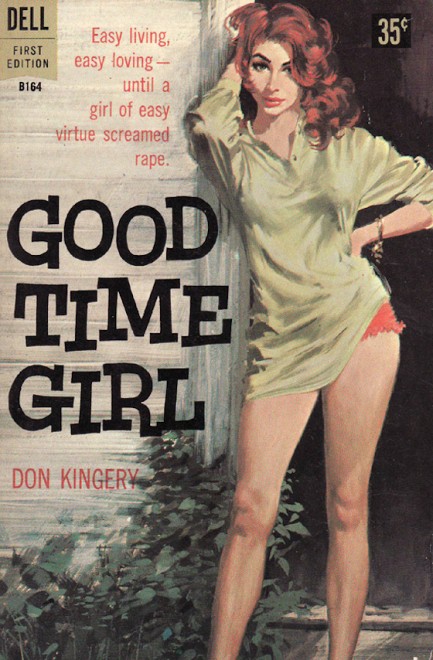
We run into Robert McGinnis everywhere. In fact, we suspect his art is so collectible that his covers are the reason some vintage paperbacks avoid oblivion. But Don Kingery's Good Time Girl, though obscure, deserves to survive on its own merits. It's a good book. The story, which is set in a small Louisiana town called Bay Ste. Marie, deals with a journalist named Jack Candless who agrees to push a false story of rape in order to advance his flagging career. The alleged victim is the town prostitute, but Candless helps make her over into a virginal good girl. The whole scheme is supposed to last only a few days, but of course it spirals completely out of control—not least because Jackie blue is a blackout drunk. This isn't the first time we've read Kingery, and it certainly won't be the last. Good Time Girl is confidently written, compellingly plotted, interestingly peopled, emotionally believable in terms of alcoholism, and has a convincing sense of place that makes clear Kingery knows the dirty south well. Top marks.
 Hell hath no fury like the pious denied. 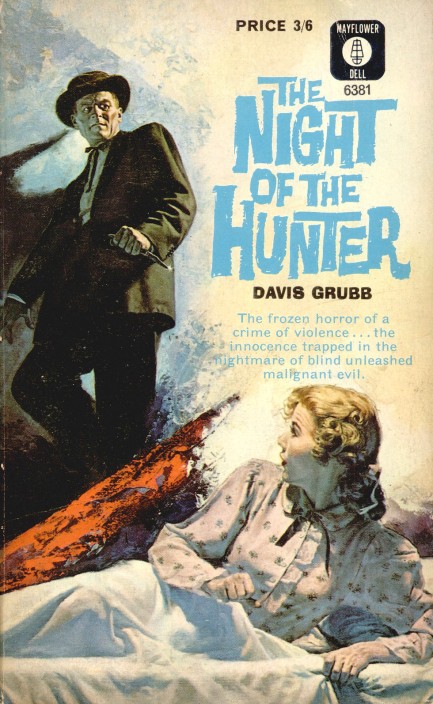
Above is a beautiful but uncredited 1964 Mayflower Dell cover for Night of the Hunter by Davis Grubb, an author we knew only from horror fiction until we read this. We'd seen the movie a few times, and it's brilliant, as everyone knows. Well, so is the book. It's well written, and of course introduced to the world its iconic serial murderer Preacher, aka Harry Powell, who has l-o-v-e tattooed across the fingers of his right hand, h-a-t-e tattooed across the left, and puts those hands to use in his violent quest for hidden bank robbery loot that may be in the possession of two children. This was Grubb's first novel, coming in 1953 originally, and it's as assured a debut as you'll ever read. Every passage in the book is good, but for a typical example, here's a short one:
Her hand rose to her mouth then, the lips gasped suddenly, and presently the teeth settled, gently, grinning, in the glass of spring water, while Icey turned her back on them and fell into the healthy sleep of a fat, innocent child. Yet Walt lay awake. It was something he had learned to do in their marriage: hammering his thoughts into the shape she wanted. It was the price of peace, of sleep itself. Whatever unframed and as yet unshaped suspicions he had of Preacher were gone—stamped and trodden into the soil of domestic orthodoxy.
It's just a couple going to bed, with one of them beginning to have doubts about the preacher who's come to town and infiltrated several lives. But even in minor passages Grubb shines, showing that good writers work hard to describe even less significant moments well. That level of attention to detail helps Grubb build tension to the point where it's hard to bear—almost to the level of one of his horror tales—as Preacher psychologically dominates the children at the center of his obsession. His mental tortures are mere precursors to his physical violence.
Night of the Hunter became a great movie because the source material was as deep and rich as a seam of buried of gold. Filmmakers often make major changes to material and produce something amazing. Other times it's best to keep riding the same horse that took you to the rodeo. For those who have never seen the film, Grubb's novel will be a special—if terrifying—treat. But we think the book is worthwhile even for those who know what's going to happen. And we consider Preacher, whose twisted interpretation of scripture is designed to serve his lust for money and power, a relevant character in 2020.
 So I couldn't help noticing all the notches on your bedpost. What are those about? 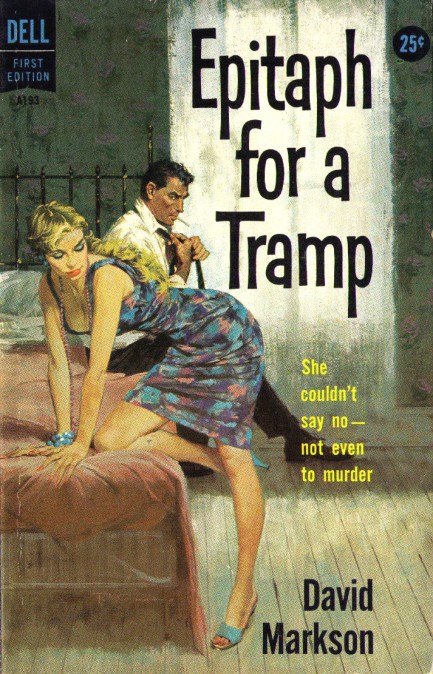
Today we have more elongation for you from the brush of grandmaster illustrator Robert McGinnis. This cover for the 1959 thriller Epitaph for a Tramp features one of his deliberately out-of-proportion femmes fatales, with a long lower half and a small head. He would stretch his girls to freakish lengths as time went by, but we especially like this phase from him. For an example of how unusual his women would get, check out these four examples we shared a while back. And if those intrigue you, there are also numerous examples of later McGinnis on the website of Hard Case Crime, with the best ones appearing here, here, and here.
Epitaph for a Tramp was written by David Markson, and the story involves a detective who finds himself drawn into danger when a mortally stabbed woman staggers through his door and dies. She's the tramp of the title, a woman who in one year of marriage cheated on her husband with—count em—thirteen men. Her cuckolded husband is occasionally sympathetic toward her, which is a bold writerly move for a period when most people—male and female—subjected women to ugly judgments for perceived sexual availability. But Markson was an ambitious author who would go on to become a celebrated literary figure with tales such as This Is Not a Novel and the acclaimed Wittgenstein's Mistress.
Here he does hard-boiled with a cleverness of phrasing that's rare, but often misses the mark too. For example, quips like, “Bare lightbulbs helped the hallway look like something other than the esophagus of a submerged whale,” just don't work. Sometimes a dim hallway can just be a dim hallway. But the story is reasonably interesting and the main character Harry Fannin fits the private dick mold well. As he tries to unmask a murderer he also unmasks a complex, troubled victim, a character who in our experience is unique in mid-century fiction. That's worth a lot, even if the book isn't perfect. We'll see if Markson did better with his second detective entry Epitaph for a Dead-Beat.
 Well, your health coverage looks comprehensive, so I've decided to give you top notch care. 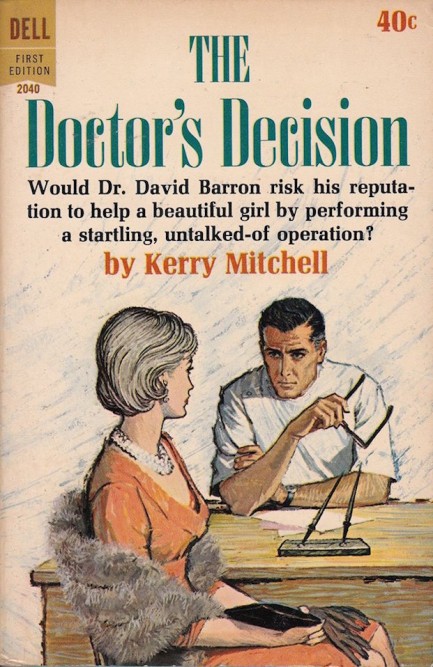
Yet another medical cover today, this one for 1967's The Doctor's Decision by Kerry Mitchell. The art is credited to someone named only Kalin. We think it's safe to conclude that's Victor Kalin, the veteran Dell Publications illustrator behind such classic fronts as Somerset Maugham's Rain and John D. MacDonald's Soft Touch. The author, Kerry Mitchell, was a pseudonym used by several writers, including Lee Pattinson, Ray Slattery, and Richard Wilkes-Hunter, and this tale deals with a plastic surgeon named David Barron who pioneers a radical new surgery, while simultaneously seeing his reputation threatened by scandal. We've run across Mitchell before. Remember Bush Nurse? That's our fave.
 Good thing we're in a district that opted for in-person classes. This wouldn't be nearly as pleasurable via Zoom. 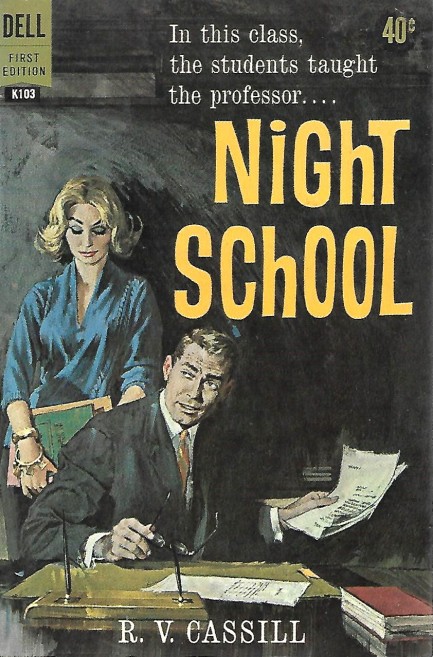
With R.V. Cassill's 1961 novel Night School we return once again to the time-honored pop fiction subject of teachers engaging in extracurriculars with students. Such affairs are nearly always frowned upon in these books, so don't go thinking these explorations represent any sort of endorsement. The authors generally come up with creative ways to get their protagonists into (and sometimes out of) seriously deep shit. But as it turns out Night School isn't even teacher sleaze. It deals in serious fashion with a once-acclaimed novelist whose run of recent hard luck finds him teaching a dead end night school course where he must deal with an assortment of students and their various issues. There's sexual content, but not much. Sleaze novels can be quite fun, but there's little more disappointing than a novel that promises then doesn't get there. But we weren't actually surprised Night School was more literary than the teaser suggests, because the legendary Robert McGinnis—the cover artist here—has never to our knowledge had his work front a sleaze novel (his romance covers don't count). We've shared several teacher sleaze covers over the years. If you want to see the best examples look here and here. And here too.
 Hollywood gets wholly weird in Bill Gault's show business thriller. 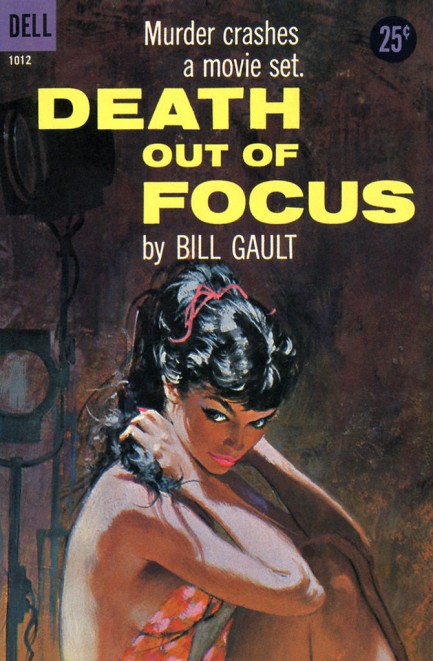
With Death Out of Focus, which is our third reading of Bill Gault, aka William Campbell Gault, we're thinking he can be moved into the trusted bin. He once more documents the decadent ins and outs of Southern California, this time centering his tale around a movie production. When director Stephen Leander's leading man ends up in the wreckage of his car at the foot of a cliff in Pacific Palisades and police call it an accident, a determined insurance investigator launches his own inquiry and begins turning up what looks like evidence of murder. Leander joins forces with the insurance guy to uncover the truth. Fun to read, quick of pace, and quirky the way a Hollywood thriller should be, Death Out of Focus takes various Tinseltown archetypes—the aging actress, the tyrannical producer, the sexy ingenue, the loyal industry wife—adds money motivations and showbiz ambitions, and ends up with a nice concoction. Like a typical Hollywood movie, it doesn't strive to be unique or lofty, but with so many literary duds out there, good enough is good enough. This Dell edition is from 1960 and the cover is by Robert McGinnis.
 Dashed hopes and bad dreams fuel classic pulp collection. 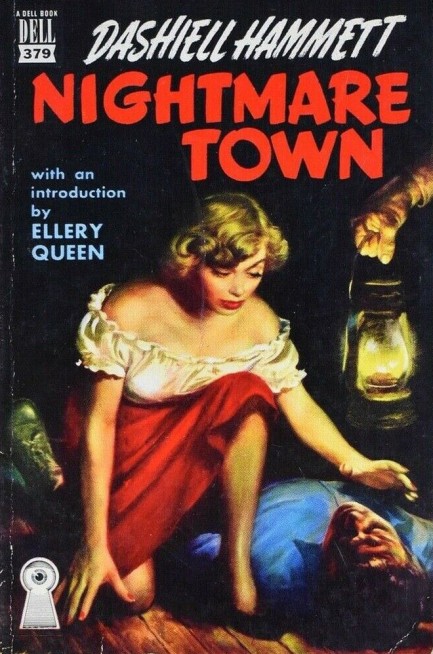
Above, a cover for Nightmare Town, which is a collection of four short stories Dashiell Hammett wrote for pulp magazines between 1924 and 1933. You get 1924's, “Nightmare Town,” best of the four tales in our opinion, which deals with a tough guy who fetches up in a lawless desert way station and soon finds himself in the middle of violence and murder. It's similar to Red Harvest, Hammett's novel of another town lashed by a bloody hellstorm, except this novella length tale ends almost apocalyptically. The other tales here are 1925's “The Scorched Face,” 1933's “Albert Pastor at Home,” and 1925's “Corkscrew.” All are good, though we think Hammett is better in longer formats. You get illustrations too. Those are not very good, objectively speaking, but you're buying this purely for the fiction anyway. Also, the 1950 Dell edition you see here is a collectible mapback edition, which is a bonus. But no matter what, Hammett always hits the spot—usually a major organ or artery.
 |  |
|
 |
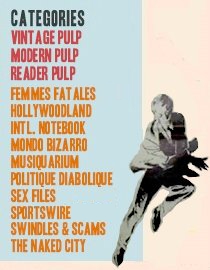
The headlines that mattered yesteryear.
1962—Marilyn Monroe Sings to John F. Kennedy
A birthday salute to U.S. President John F. Kennedy takes place at Madison Square Garden, in New York City. The highlight is Marilyn Monroe's breathy rendition of "Happy Birthday," which does more to fuel speculation that the two were sexually involved than any actual evidence. 1926—Aimee Semple McPherson Disappears
In the U.S., Canadian born evangelist Aimee Semple McPherson disappears from Venice Beach, California in the middle of the afternoon. She is initially thought to have drowned, but on June 23, McPherson stumbles out of the desert in Agua Prieta, a Mexican town across the border from Douglas, Arizona, claiming to have been kidnapped, drugged, tortured and held for ransom in a shack by two people named Steve and Mexicali Rose. However, it soon becomes clear that McPherson's tale is fabricated, though to this day the reasons behind it remain unknown. 1964—Mods and Rockers Jailed After Riots
In Britain, scores of youths are jailed following a weekend of violent clashes between gangs of Mods and Rockers in Brighton and other south coast resorts. Mods listened to ska music and The Who, wore suits and rode Italian scooters, while Rockers listened to Elvis and Gene Vincent, and rode motorcycles. These differences triggered the violence. 1974—Police Raid SLA Headquarters
In the U.S., Los Angeles police raid the headquarters of the revolutionary group the Symbionese Liberation Army, resulting in the deaths of six members. The SLA had gained international notoriety by kidnapping nineteen-year old media heiress Patty Hearst from her Berkeley, California apartment, an act which precipitated her participation in an armed bank robbery. 1978—Charlie Chaplin's Missing Body Is Found
Eleven weeks after it was disinterred and stolen from a grave in Corsier near Lausanne, Switzerland, Charlie Chaplin's corpse is found by police. Two men—Roman Wardas, a 24-year-old Pole, and Gantscho Ganev, a 38-year-old Bulgarian—are convicted in December of stealing the coffin and trying to extort £400,000 from the Chaplin family.
|

|
|
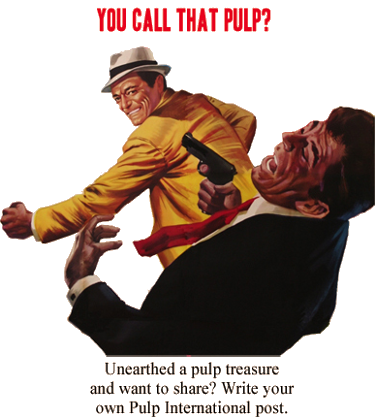
It's easy. We have an uploader that makes it a snap. Use it to submit your art, text, header, and subhead. Your post can be funny, serious, or anything in between, as long as it's vintage pulp. You'll get a byline and experience the fleeting pride of free authorship. We'll edit your post for typos, but the rest is up to you. Click here to give us your best shot.

|
|





















